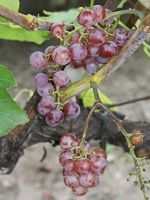Mon-Fri 9am - 5pm Mountain time
Somerset Grape vs Bilberry
Vaccinium myrtillus
Vitis Somerset
CUSTOM GROW
Bilberry is a native perennial shrub valued for its small, blue-black berries that ripen in mid to late summer. The berries resemble blueberries but have a richer, more tart, and intense flavor. They have long been used for fresh eating, baking, and preserves, while also providing food for birds and mammals. In spring, its delicate pinkish flowers attract bees and other pollinators.
Growing low to the ground, Bilberry forms spreading colonies that create dense understory cover. This growth habit provides food and shelter for wildlife, and its foliage adds seasonal interest by turning red to purple in autumn. With its adaptability and ecological benefits, Bilberry is well-suited for naturalization, ecological restoration, and pollinator gardens.
The Somerset Grape is a cold-hardy variety that is sweet, with a hint of a strawberry taste and tender skin, making them excellent for fresh eating. The grapes grow throughout the summer and go from a light pink and deepen in color as they ripen. The grapes will be at their peak sweetness in mid to late September, making that the best time for harvest.
The Somerset Grape is considered a seedless variety. Occasionally the fruit will contain seeds, but they are soft and barely noticeable. The grapes themselves are a bit smaller than the average size you’d find in the grocery store, however the cluster is compact and quite big. This vine is best supported with a trellis.
Note: We do not ship grape vines to BC due to regulatory restrictions from the Canadian Food Inspection Agency.
Bilberry Quick Facts
Somerset Grape Quick Facts
Toxicity: leaves may be unsafe in high doses

